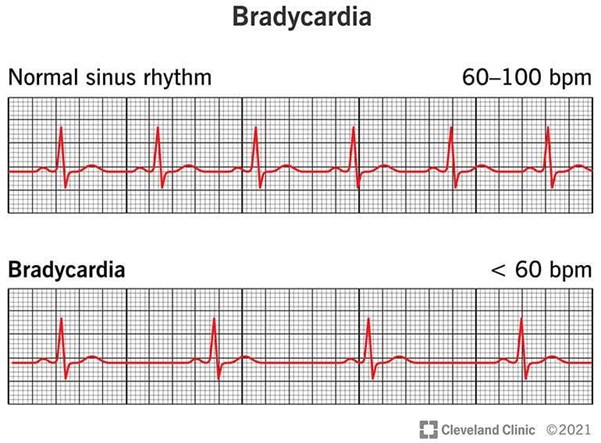A nurse in a pediatric clinic is providing teaching to the guardian of an infant who has a new prescription for digoxin.
Which of the following manifestations should the nurse include as an indication of digoxin toxicity?
Polyuria.
Diaphoresis.
Bradycardia.
Jaundice.
The Correct Answer is C
Bradycardia, or a slow heart rate, is a sign of digoxin toxicity in infants.

Digoxin is a medication used to improve the strength and efficiency of the heart and to control the rate and rhythm of the heartbeat.
However, an overdose can cause changes in the rate or rhythm of the heartbeat, including bradycardia.
Choice A is wrong because polyuria is not a sign of digoxin toxicity.
Choice B is wrong because diaphoresis is not a sign of digoxin toxicity.
Choice D is wrong because jaundice is not a sign of digoxin toxicity.
Nursing Test Bank
Naxlex Comprehensive Predictor Exams
Related Questions
Correct Answer is A
Explanation
Following the child’s home sleep routine can help reduce anxiety and promote adequate sleep.
Children thrive on routine and consistency, and maintaining their usual sleep routine can provide a sense of familiarity and comfort in an unfamiliar environment.
Choice B is wrong because leaving the lights on can disrupt the child’s sleep.
Choice C is wrong because allowing the child to adjust their bedtime may disrupt their sleep routine and lead to inadequate sleep.
Choice D is a good option, but following the child’s home sleep routine is the best way to promote adequate sleep.
Correct Answer is D
Explanation
The accessory nerve is tested by evaluating the function of the trapezius and sternocleidomastoid muscles.
The trapezius muscle is tested by asking the patient to shrug their shoulders with and without resistance.
Choice A is wrong because following a light in the six cardinal positions tests the function of cranial nerves III, IV, and VI.
Choice B is wrong because moving their tongue in all directions tests the function of cranial nerve XII.
Choice C is wrong because showing their teeth while smiling tests the function of cranial nerve VII.
Whether you are a student looking to ace your exams or a practicing nurse seeking to enhance your expertise , our nursing education contents will empower you with the confidence and competence to make a difference in the lives of patients and become a respected leader in the healthcare field.
Visit Naxlex, invest in your future and unlock endless possibilities with our unparalleled nursing education contents today
Report Wrong Answer on the Current Question
Do you disagree with the answer? If yes, what is your expected answer? Explain.
Kindly be descriptive with the issue you are facing.
